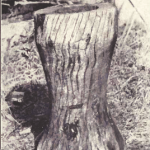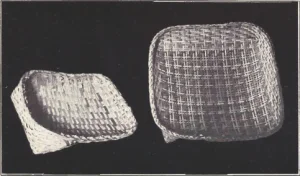Unfortunately, comparatively few of the articles of food used by the primitive Choctaw are known to the members of the tribe of whom this paper treats. They are able to give, however, the names of a few plants that are even now used.
Ahe (Smilax laurifolia)
The hard bulbous roots are pounded fine, a small amount of water is added if necessary, and the paste is made into small cakes, which are fried in grease. The Choctaw say that formerly bear’s grease was always used for this purpose. Ahe is spoken of as having been one of their favorite foods.
Ahelo’sa (Phaseolus diversifolius)
The roots are first thoroughly boiled, then mashed, and served as food.
Nuse (acorns of the Quercus aquatica)
These acorns were pounded in a wooden mortar until fine. The meal was then put into an openwork basket and water was poured through several times. It was then boiled or used as cornmeal.
Okesok (nuts of the Juglans squamosa)
The nuts were cracked and the meat was removed. When a sufficient quantity had been obtained, the meat was pounded and made into a paste, which was beaten up in a small quantity of boiling water. The mixture was then eaten as a broth or soup.
Kombo ashish
The leaves of Laurus sassafras are gathered during the autumn, usually about the middle of October, after they have turned red. They are thoroughly dried in the sun and air, without the use of artificial heat. They are then pounded in a wooden mortar until reduced to a very fine powder, which is sifted to remove all hard particles. The powder is again placed in the mortar and pounded until as fine as it can he made, when it is ready for use. About a teaspoonful of this powder added to a kettle of soup gives it a glutinous quality and the flavor also is relished. This powder is highly prized by the Creoles of Louisiana.
Tonche (Zea mays)
Corn is allowed to ripen and harden on the cob; then it is removed and dried thoroughly over hot ashes. Next, it is put into a wooden mortar (kîte), plate 1, and pounded with a wooden pestle (kêtoke), plate 2, after which it is placed in a winnowing basket (obfko’), plate 3. The obfko’ is held horizontal, with the fiat edge away from the operator; it is jerked back and forth, up and down, thereby throwing the crushed grain a foot or more into the air. The lighter particles are carried off and fall into the large flat basket (tapa), plate 3, resting on the ground. The portion of the grain remaining in the obfko’ is again pounded in the mortar and subsequently passed through a sieve (ishsho’ha), plate 3. The fine particles that pass through the sieve are known as botu; the coarser portion remaining in the sieve is called tonlache. Much of the botu was parched and eaten mixed with water; but most of the coarser tonlache was boiled either with or without meat. Corn is said to have been extensively raised by the Choctaw during past years. Beans and potatoes were also raised, but no other vegetables are remembered.



Wild crabapples
Gathered and dried on a frame arranged over a bed of hot ashes and coals. This appears to be the only fruit that is preserved in any manner and kept for future use. Many kinds of haws and berries grow in great quantities in the vicinity of Bayou Lacomb, but it is said they are never dried, being eaten only when fresh.
Honoshe (rice)
The Choctaw have a very simple method of preparing rice. After being gathered and dried, it is pounded in a wooden mortar (kîte), with a wooden pestle (kêtoke), care being taken not to crush the grain more than can be avoided. Next the chaff is removed by shaking the grain up and down in a winnowing basket (obfko’), the chaff falling into the large tapa. If all the husks are not loosened during the first pounding, the grain is again pounded in the mortar and later winnowed. It is then sifted to remove the broken grains, and afterward washed and dried.
Game
Game was formerly abundant throughout lower Louisiana and venison and bear’s meat were important articles of food, either fresh or dried. The Choctaw method of preserving meat may be described as follows: Thin strips were hung on sticks or spread over a frame, or in the thick smoke from a fire on which green or wet wood had been placed. Meat thus prepared during the cold months would remain good throughout the following spring and summer. Large quantities were formerly prepared in this way. Pork is now similarly treated.
Fish
As they live where fish are abundant and easily caught, it is remarkable that the Choctaw seldom, if ever, eat them. At times, however, large trout and shrimp were dried in the sun for future use.
